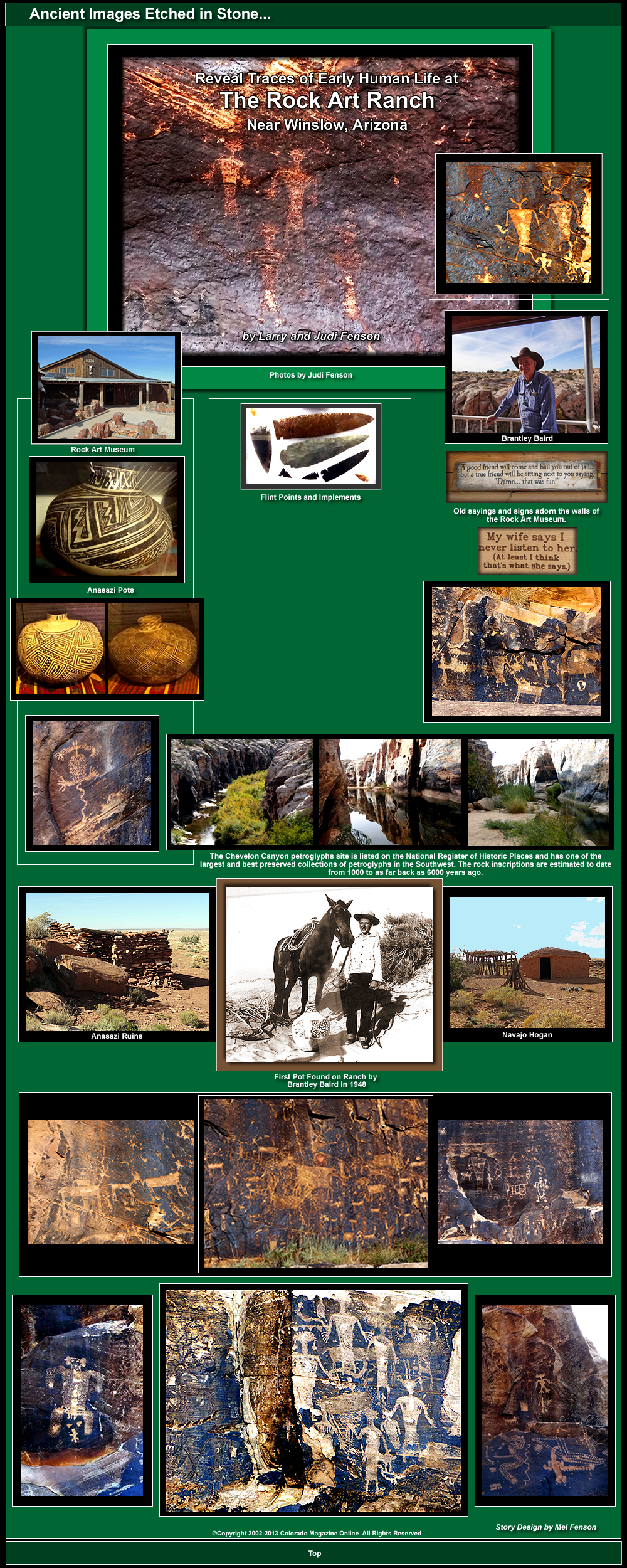

Near the house where he lives part time, he has built a large barn like structure that serves as a museum and can also accommodate groups of up to 50 for chuck wagon dinners. The place is filled with family memorabilia old signs, sayings, an authentic covered wagon and artifacts that Brantley has found on his 5000 acres over the years.
After our tour of the museum, we got back in our cars and followed Brantley (in his battered pickup, of course) about 4 miles to a rise where there are several very old Native American dwellings. There is a classic Navajo hogan and a sweat house in very good condition. The age is unknown. Two elderly Navajos stopped by once and said they had lived there as children and wanted to see the place again. Some other Navajos come every few years and re-mud them. About 100 feet away is a much older Anasazi dwelling. Pottery shards litter the ground.
Brantley said he has found most of the pots and other implements while on horseback after a rainstorm or a strong wind storm had exposed them. He is obviously proud of his spread and all the history it holds and is genuinely interested in it. But he realistically understands how little is really known about its past. He says he gets the most useful information not from academics who spend time there but from Native Americans. When you ask him how old a pot is or what a given implement was for, sometimes he will tell you outright (typically based on what he has learned from Native American contacts). But quite often he will say "we just don't know."
A number of Arizona universities have sponsored digs and field training on the ranch, focusing on ruins scattered throughout the property as well as on the petroglyphs in Chevelon Canyon. In 2011, a contingent of professors and students from the anthropology department at the University of Arizona discovered 15 sites on the ranch, some dating back 5000 years. The team carried out excavations at two small pueblos, revealing rooms with stone masonry dating back 800 years. Further work was done this year.
Next we got back in our cars and continued a couple miles further to the edge of a really beautiful river canyon. You would never expect it to be there as the surrounding terrain is so flat. Brantley has constructed an overlook and a series of maybe 30 metal steps and walkways with railings that takes you about 60 feet down to the base of the canyon.
The Chevelon Canyon petroglyphs site is listed on the National Register of Historic Places and a number of experts have described it as one of the largest and best preserved collections of petroglyphs in the Southwest. The rock inscriptions are estimated to date from 1000 to as far back as 6000 years ago.
The canyon is very steep, narrow
and full of petroglyphs, many in very good condition.
A shallow river covers the bottom but there is room to walk on either
side for about
1/3rd of a mile. There are places where you can easily hop on some flat
rocks in the center of the river to get a better perspective.
It was kind of amazing to have completely free access to the site. Fortunately, because of the position of the art, it would be a little difficult to get close enough to touch any.
The bewildering mix of subjects and styles appearing on this wall is typical of the rock art found throughout Arizona. The figures and designs are intriguing and appealing but at the same time frustrating. You have no clues as to why the figures were drawn, why disparate subjects were combined or what purposes they served.
Speculation is rampant among
scholars who study rock art. Life must have been quite difficult in
those times with most of a group's waking hours devoted to hunting and
gathering, battling the elements and possibly defense of territory.
There had to be important reasons why at least some members of the group
would allocate time to the creation of petroglyphs. Among the reasons
that have been proposed are these:
(1) marking of territory (2) attempts to gain power over hunted animals
(3) depiction of magical powers of a shaman to impress group members
(4) portrayal of psychedelic states after the ingestion of psychotropic
herbs or behavioral procedures (e.g., dancing or spinning) in order
to gain access to or communicate with the spirit world.
And then there are inexplicable designs sometimes combined with humans and/or animals. What could they mean? What was their purpose?
Some panels include a curious assortment of animals, humanoid forms and designs. Were these etched in the stone as some sort of grand whole or were they carved at separate times by different individuals without any integrative purpose?
In one place, at least three distinctly different humanoid shapes appear close together leading us to wonder whether they were created at different times by different artists.
He charges $35 per person and you can return as many times as you like - for free! We plan to.